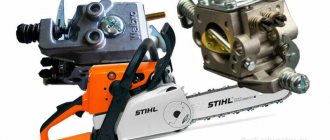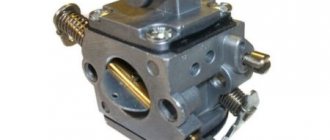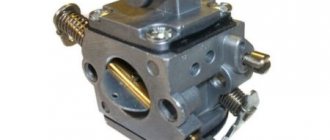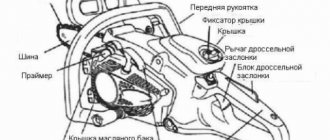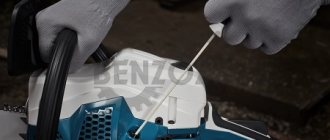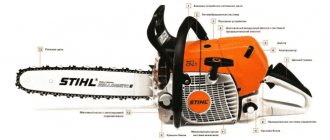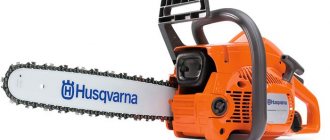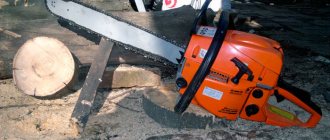Regardless of complexity, tasks and frequency of use, all tools require periodic maintenance or repair. Chainsaws are no exception, despite their thoughtful design and performance characteristics. But, like all equipment with moving parts, chainsaws are subject to wear and tear and require periodic inspection. And first of all, such parts include the saw chain, to extend the service life of which, timely replacement of the sprocket is important. This is exactly what we will talk about in this article.
When and why do you need to replace a worn chainsaw sprocket?
The drive sprocket of a chainsaw or electric saw is one of the most important parts of the sawing machine. The main function of the chainsaw sprocket is to transmit engine torque to the saw chain. This transmission is carried out through a centrifugal clutch. By type, sprockets can be divided into professional and household, just like chains. During the operation of the chainsaw and sawing wood, the drive sprocket, like the chain, gradually wears out.
Husqvarna drive sprocket
Let's find out in more detail why it is necessary to replace a worn chainsaw or electric saw sprocket and when is the best time to perform such a replacement.
The main signs that the sprocket needs to be changed:
- The chain on your chainsaw has been replaced twice (one of the current operating rules for chainsaws and electric saws is that if you use the tool frequently and actively, after two chain changes you should replace the drive sprocket);
- the quality of sawing deteriorated, the chain began to need tightening more often;
- you have installed a new chain to which the old drive sprocket does not fit (this part is not universal, and also has its own pitch, in addition, the pitches of the drive and driven chain sprockets must match, otherwise the tool will not work);
- you are using a different tire, shorter or longer.
Video about replacing a sprocket on a chainsaw:
How to change pistons on a Husqvarna 137 chainsaw?
If the Husqvarna 137 chainsaw does not start, the first thing to do is disassemble the saw and inspect the cylinder-piston group of the tool. The parts of this unit are subject to significant wear, which leads to breakdown of the chainsaw.
To replace Husqvarna 137 pistons, you should choose parts with a diameter of 3.8 cm. Having purchased spare parts of the required size, you will need to disassemble the saw motor and remove the faulty elements. Then you need to install the piston pin and rubber sealing rings. After this, you will need to rotate the seals 360 ° - this will ensure that the rings fit into the grooves intended for them.
Why do you need to replace the sprocket?
A worn sprocket must be removed for the following reasons:
- with an old sprocket, the saw chain will stretch very quickly - after just a few uses the chain will hang, and tensioning will not help;
- if you put a new chain on an old sprocket, the smoothness of the chain will decrease, the quality of the cut will deteriorate, the chain will lead to the side when cutting;
- the general wear and tear of the chainsaw will accelerate, the tool may fail at any time;
- The chain may break or the chain will jam during operation (danger of hand injuries and damage to the body of the electric saw or chainsaw);
- the tire will heat up faster, which will lead to rapid overheating of the chainsaw;
- the load on the engine and body will increase.
Important! You cannot change sprocket sizes at your own discretion during repairs; use the manufacturer’s standard. Unauthorized replacement will lead to deterioration in the technical performance of the chainsaw or electric saw.
Video on how to change the sprocket on a chainsaw:
Technical characteristics of the Husqvarna 137 chainsaw
A balanced design and the use of high-quality components allowed Husqvarna to achieve good technical characteristics in the production of the 137th model. The most important parameters of the Husqvarna 137 chainsaw are described in the table below.
| Chainsaw motor type | Gasoline internal combustion engine |
| Cylinder volume | 36.3 cm3 |
| Motor power | 2.2 kW/1.64 l. With. |
| Fuel mixture tank volume | 420 ml |
| Oil tank volume | 200 ml |
| Possible length of bus used | 33–38 cm |
| Chain pitch | 0,325 “ |
| Fully assembled weight | 5.5 kg |
The factory characteristics of the Husqvarna 137 chainsaw cannot be called high. However, the parameters set by the manufacturer are quite sufficient for quick and efficient work in the local area and in the garden.
Are there ways to extend the life of an existing sprocket?
The main ways to extend the working life of a chainsaw drive sprocket:
- use several chains (preferably three). This method is the most gentle and convenient for the chainsaw owner in that there is no need to constantly tighten a chain worn out by intensive work. Operating three chains in turn will save the life of the sprocket and delay its replacement;
- high-quality maintenance of the drive sprocket bearing. This part plays an important role in the functioning of both the drive sprocket and the engine. For lubrication, it is recommended to use a special lubricant. The sprocket bearing is not constantly engaged, but only at idle speed, and therefore requires periodic lubrication. You can use a tire nose lubricant, such as standard lubricant from Repsol or Husqvarna.
Features of saw chains
The working mechanism of the saw is the chain. The production of saw chains is carried out using a special technology:
- The cutting element is made of high-carbon steel, and chrome plating or a pobedite layer is applied to the cutter. The more complex the manufacturing technology, the higher the cost of the chain.
- The hinge holes are ground to reduce friction and extend service life.
- Only rivets that are hardened using a special technology are used.
- Marks are applied to the teeth, by which you can determine wear and perform uniform sharpening.
- After connecting the links into a chain, the product is stretched to ensure dimensional stability during operation.
A sophisticated automatic chain lubrication system increases service life. New saws must be selected according to the characteristics specified in the operating instructions for the Shtil 180 chainsaw.
You need to know that chains with pobedite surfacing are 3-5 times more expensive than regular chains, but it is impossible to sharpen them with your own hands when repairing a Shtil 180 chainsaw. Employees of the Ministry of Emergency Situations use this tool more often.
For a long maintenance-free period, it is necessary to use the oil recommended by the tool manufacturer. A special mineral composition is used to prevent the chain from pitching. It is unacceptable to use oil intended to be added to gasoline for Stihl saws.
People often ask whether it is possible to make longitudinal cuts with a Shtil 180 saw. The power of the saw allows you to cut wood only across the grain.
The price of the Stihl MS 180 chainsaw differs significantly. The most inexpensive basic model of the usual configuration. The cost of the device depends on the country of manufacture. A German or American product is more expensive than a Chinese one for well-known reasons.
Gasoline chainsaws, like most other tools, require periodic diagnosis of breakdowns and replacement of worn parts. A significant part of them are associated with the chainsaw drive sprocket or clutch disc - one of the important elements of all chainsaws without exception. Despite the relative simplicity of its design and the instructions in the operating instructions, every year thousands of inexperienced craftsmen reach a dead end in this matter and waste money on service centers or produce it incorrectly, which further aggravates the problem.
What tools are needed to replace the sprocket?
To replace the drive (drive) sprocket you will need the following tools and components:
- a special key for removing this part (usually supplied with expensive branded chainsaws; cheap saws are not equipped with such a key);
- a drift made of aluminum or copper (only from soft metals and only in the absence of a key);
- hammer (for striking the drift while unscrewing the sprocket);
- flat screwdriver for tightening the nut;
- sprocket bearing grease.
Oil supply system repair
If there is no oil supply to lubricate the chain, it is necessary to diagnose the entire system and determine the reason why the oil is not supplied. There may be several main reasons:
- Clogged oil filter or oil system;
- Missing thread on the oil pump worm gear;
- Blockage or malfunction of the pump itself;
- Depressurization of the oil system (there will be oil leaks on the bottom of the chainsaw).
To check the threads on the worm drive of the oil pump, you will need to remove the chainsaw drive sprocket and unscrew the clutch. To do this, the spark plug is unscrewed and a piston stopper is installed in its place, thereby ensuring reliable fixation of the tool’s crankshaft from turning.
Next, remove the cover from the side of the bar of the Shtil 180 chainsaw, and using a screwdriver, remove the retaining ring holding the drive sprocket, after which the sprocket itself is removed.
The clutch is untwisted using a 19mm socket and a wrench. It is necessary to unscrew the clutch clockwise, since the thread is left-handed. There is a reflective plate behind the clutch, this also needs to be removed. The next part is the worm drive of the oil pump. Having examined and discovered the absence of a plastic thread, you can safely throw out the part and install a new one in its place, since it is impossible to restore it. Assembling the Shtil 180 chainsaw is carried out in the reverse order.
If the gear is in normal condition, disassembling the saw continues; for this, the corkscrews are removed from the shock absorbers, the rear handle is untwisted and the throttle control rod is disconnected, after which the handle block is removed from the shock absorbers using a powerful slotted screwdriver.
It is necessary to remove the handles to provide access to the bottom where the oil pump is installed.
At the next stage, the oil hose coming from the oil tank is removed from its seat on the body and the line is checked for blockages by supplying air through the oil hose into the oil tank body. If a blockage is detected, it must be cleaned; if this is not possible, the faulty hose must be replaced.
Next, the oil pump is removed from the body of the Shtil 180 chainsaw and washed in gasoline.
After repair, we assemble the Stihl 180 chainsaw in the reverse order. An important point is to seal the oil hose at the installation site, into the seat on the housing. It is necessary to rinse the hose and the hole for its installation with gasoline, then blow with compressed air until completely dry and coat it with sealing oil-resistant sealant, and then install it in place.
Design problems, differences between different models
Branded chainsaws have a special design that does not allow replacing a worn drive without removing the clutch and other parts of the chainsaw. That is, the saw needs to be almost completely disassembled. More modern models of expensive chainsaws are always equipped with a special key.
Replacing a sprocket on a chainsaw
Also, the owner of a chainsaw may encounter the following nuance: on Chinese imported chainsaws or electric saws, the sprocket on the clutch mechanism may be located in an unusual way. On older models, when the chain teeth wear out, you need to unscrew and replace the one-piece drum with the drive. On newer models, the sprocket can be replaced separately.
Sequencing
Chainsaw sprocket, ring and bearing
The vast majority of household saws are sold under the Partner brand. It is enough to simply change the sprocket in them, even at home, by purchasing a repair kit.
Since most often the sprocket in household saws is a assembled mechanism, it rotates due to the bearing. That is, when changing the sprocket, you inevitably change the bearing and the shaft.
In professional models (such as Shtil and Husqvarna), as well as in household ones, if it is not possible to have a specialized wrench on hand for removing the star, they use a soft cord with a diameter of 5-6 mm.
In all cases, the sequence of actions is as follows:
- The side cover must be opened to gain access to the tire and sprocket.
- Next, you need to remove the tire by loosening the chain.
This is what a chainsaw tire looks like
- Once the sprocket is free, you need to unscrew the spark plug to gain access to the engine piston.
Algorithm for self-replacement of the clutch drum with sprocket
How to replace the drive sprocket on an electric saw or chainsaw - more on this below.
To replace the sprocket, you need to do the following:
- remove the chain brake cover and pull it towards you (avoid contact of the brake band with the clutch parts);
- using a wrench, loosen the nuts holding the chain tension and the chainsaw cover;
- remove the chain and then the bar, removing debris and sawdust from the mounting holes;
- we fix the piston in the cylinder using a regular cord, but if possible, you need to use a piston stopper or a special lock;
- the clutch begins to rotate and does this until the piston touches the exhaust port;
- after which the stopper or cord is lowered into the candle opening and fixed there by tying several knots (the stopper will fix itself);
- unscrew the clutch nut (note that the thread of this nut is left-handed, take this into account when unscrewing);
- It is prohibited to use hard tools so as not to break the soft metal of the clutch nut;
- then the clutch is removed;
- then remove the sprocket gear itself;
- replace the old sprocket with a new one;
- Reassemble the structure in reverse order.
Alternative solutions
The sequence of operating moments is identical for almost all known models on the domestic market of chainsaw equipment. Experts advise using a branded part for replacement.
If we are talking about modernizing this unit, the feasibility of such a change should be clarified by consulting an experienced specialist.
The best option is to purchase a repair kit, which also includes a replacement bearing. In addition to the key, you may need a clutch drum puller individual for each model, a metal or plastic stopper to fix the piston in a given position.
Features of saw designs
Professional chainsaw from STIHL
There are already several dozen chainsaws in operation from different manufacturers, capacities, and most importantly for special purposes. Saws are divided into:
- professional (for felling and construction);
- household (garden).
Accordingly, their drive gear will be different, as will the sequence of actions. This is a feature of saw gear devices. For most professional tools, the tire can change its position on the saw in two planes.
The main malfunctions of chainsaws and steps to eliminate them are described here.
Tensioners
The classic chain tensioner for a budget-class chainsaw is usually a threaded bolt with an adjusting component, standard or side-mounted. The chain tension is adjusted using the included key or screwdriver.
More expensive models are equipped with easy-to-use devices that allow you to tension the chain with one movement of a lever or turn of an adjusting dial.
In the first case, the degree of tension is fixed with a locknut, in the second, the bar and chain tensioner are locked in a given position by installing the cover. In both options, reliable fixation of the chain in a given position is guaranteed, the ability to compensate for its stretching with minimal loss of working time.
